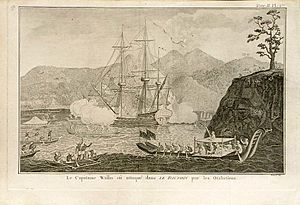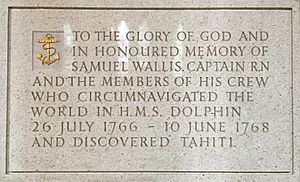HMS Dolphin (1751) facts for kids

HMS Dolphin at Tahiti 1767
|
|
Quick facts for kids History |
|
|---|---|
| Name | HMS Dolphin |
| Ordered | 26 September 1747 |
| Builder | Woolwich Dockyard, England |
| Laid down | 3 August 1748 |
| Launched | 1 May 1751 |
| Commissioned | June 1752 |
| Fate | Broken up, January 1777 |
| General characteristics | |
| Class and type | Sixth-rate frigate |
| Tons burthen | 511 2⁄94 (bm) |
| Length |
|
| Beam | 32 ft 1 in (9.78 m) |
| Depth of hold | 11 ft (3.4 m) |
| Propulsion | Sails |
| Sail plan | Full-rigged ship |
| Complement | 160 |
| Armament |
|
HMS Dolphin was a special ship of the Royal Navy (the British navy). It was a 24-gun frigate, which is a type of warship. Launched in 1751, the Dolphin became a survey ship in 1764.
This ship made history by completing two circumnavigations of the world. A circumnavigation means sailing all the way around the globe. The first journey was led by John Byron, and the second by Samuel Wallis. Dolphin was the first ship ever to sail around the world twice! She stayed in service until 1776 and was taken apart in 1777.
Contents
Building the Dolphin
The Dolphin was first ordered in 1747 from a private shipyard. But the company went out of business. So, the ship was then built at Woolwich Dockyard in England.
To protect the ship from tiny sea worms that could damage the wood, the Dolphin's hull was covered with copper. This special copper covering was added before her first big voyage around the world in 1764.
Early Adventures at Sea
Soon after the Dolphin was ready, the Seven Years' War started in Europe. In May 1756, Britain declared war on France. The Dolphin was used throughout this war.
She was part of the Battle of Minorca in 1756. During this battle, a British fleet led by Admiral John Byng failed to help their base in the Mediterranean Sea.
First Trip Around the World
After Britain won the Seven Years' War in 1763, the country wanted to explore more. They aimed to expand trade and influence around the world. People were especially interested in the Pacific Ocean. They thought it might be a new way to reach the East Indies.
There was also a popular idea that a huge, unknown continent existed in the southern part of the world. This land, called Terra Australis Incognita (meaning "unknown southern land"), was thought to balance out the land in the northern half of the world.
Since the war was over, the British Admiralty (the navy's leaders) had more money and ships for exploration. So, they planned an expedition. Their goals were to find a base in the South Atlantic and explore for new lands. These new lands could then be claimed by Britain.
The Dolphin was chosen to lead this important voyage. She sailed with another smaller ship called HMS Tamar.
Who Led the First Voyage?
The captain of the Dolphin for this journey was Commodore John Byron. He was 42 years old and an experienced sailor.
Between June 1764 and May 1766, the Dolphin sailed all the way around the globe. This was the fastest circumnavigation at that time, taking less than two years.
Discoveries on the First Voyage
During this trip, in 1765, Byron claimed the Falkland Islands for Britain. He said Britain had discovered them first. This almost caused a war between Britain and Spain. Both countries had navies ready to fight over these islands.
Later, Byron visited islands in the Tuamotus, Tokelau, and Nikunau in the Gilbert Islands. He put these islands on European maps for the first time. For over 100 years, Nikunau was known as "Byron Island." He also visited Tinian in the Northern Marianas Islands.
Second Trip Around the World
The Dolphin sailed around the world a second time. This journey was led by Samuel Wallis. Some of the crew members from Byron's first trip, like John Gore, joined Wallis on this voyage.
The ship's master, George Robertson, later wrote a book about this journey. It was called The discovery of Tahiti; a journal of the second voyage of H.M.S. Dolphin round the world under the command of Captain Wallis, R.N., in the years 1766, 1767, and 1768.
The Dolphin set sail in 1766 with another ship, HMS Swallow. The Swallow was commanded by Philip Carteret, who had also been on Byron's first voyage.
Landing in Tahiti
On June 17, 1767, the Dolphin dropped anchor near Tahiti Iti. Wallis soon moved the ship to a better spot, Matavai Bay, on June 23.
Even though Spanish explorers had visited the Marquesas Islands in 1595, Wallis officially claimed Otaheiti (Tahiti) for Britain. He named it "King George III Island." About a year later, a French explorer named Louis-Antoine de Bougainville landed on the other side of Tahiti. Not knowing Wallis had been there, he claimed it for the King of France.
Interactions with Locals
At first, a large canoe approached the Dolphin. Its occupants threw stones at the British sailors. The British fired back, damaging the canoe and causing many injuries. Wallis then sent his carpenters ashore to cut many local canoes in half.
Eventually, the British sailors and the local people became friendly. The locals were eager to trade their goods for iron. This trade became so popular that the sailors started trading the ship's nails! This caused a problem because losing too many nails could make the Dolphin unsafe.
See also
- European and American voyages of scientific exploration


